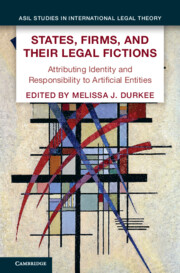 States, Firms, and Their Legal Fictions
States, Firms, and Their Legal Fictions Book contents
- States, Firms, and Their Legal Fictions
- ASIL Studies in International Legal Theory
- States, Firms, and Their Legal Fictions
- Copyright page
- Contents
- Contributors
- Acknowledgments
- 1 Introduction
- Part I International Attribution
- 2 Attribution in International Law
- 3 Between States and Firms
- 4 Contractors and Hybrid Warfare
- 5 The Enduring Charter
- Part II Transnational Attribution
- Part III Domestic Attribution
- Part IV Conceptual Origins and Lineages
- Index
2 - Attribution in International Law
Challenges and Evolution
from Part I - International Attribution
Published online by Cambridge University Press: 29 February 2024
- States, Firms, and Their Legal Fictions
- ASIL Studies in International Legal Theory
- States, Firms, and Their Legal Fictions
- Copyright page
- Contents
- Contributors
- Acknowledgments
- 1 Introduction
- Part I International Attribution
- 2 Attribution in International Law
- 3 Between States and Firms
- 4 Contractors and Hybrid Warfare
- 5 The Enduring Charter
- Part II Transnational Attribution
- Part III Domestic Attribution
- Part IV Conceptual Origins and Lineages
- Index
Summary
The doctrine of attribution in international law has been defined, in large part, by the International Law Commission’s (ILC) provisions on attribution of conduct in the Articles on State Responsibility for Internationally Wrongful Acts (ARSIWA). It is uncontroversial to note that despite the influence of the ILC’s rules on attribution, the regime of international responsibility remains underdeveloped. In addition to being underinclusive, the rules of attribution in ARSIWA are beginning to appear outdated. The central question, therefore, is whether the rules of attribution in ARSIWA are flexible enough to accommodate two disparate trends. On the one hand, we have witnessed an outsourcing of public functions to private actors in areas such as immigration, prison management, and education, whereby privatization has reduced state control and, consequently, potential state responsibility. On the other hand, there is a marked centralization of power in SOEs, some of which are now playing a global role as investors. This chapter assesses whether the default rules on attribution are flexible enough to manage both ends of the spectrum of state activity, which will be a crucial issue for regulators going forward.
Keywords
- Type
- Chapter
- Information
- States, Firms, and Their Legal FictionsAttributing Identity and Responsibility to Artificial Entities, pp. 25 - 46Publisher: Cambridge University PressPrint publication year: 2024
